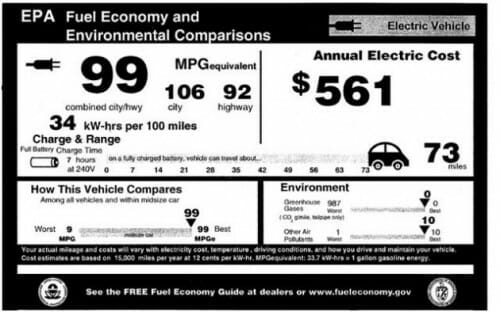The Electric Vehicle Mileage Fraud Update: Singapore Figures It Out
Long-time readers know that while I have no particular problems with electric cars, I do think that the EPA uses fraudulent standards for evaluating the equivalent fuel economy or MPGe of electric vehicles. In short, the current Obama standard ignores the previous Clinton-era methodology and creates a crazy new standard that assumes fossil fuels are burned with perfect efficiency when making electricity. Most of my readers (but perhaps few Obama voters) will understand this assumption to be absurd. The result is, as discussed here in Forbes, that the current MPGe numbers for electric vehicles are overstated by a factor of 3 (specifically you need to multiply them by 36.5% to get the correct equivalent amount of fossil fuels that must be burned in the power plant to power the electric car). When this correction is made, cars like the Nissan Leaf are good (but not as good as a Prius) and cars like the old Fiskers Karma get worse mileage than a SUV.
As I wrote in the article on the Karma,
...electric vehicle makers want to pretend that the electricity to charge the car comes from magic sparkle ponies sprinkling pixie dust rather than burning fossil fuels. Take this quote, for example:
a Karma driver with a 40-mile commute who starts each day with a full battery charge will only need to visit the gas station about every 1,000 miles and would use just 9 gallons of gasoline per month.
This is true as far as it goes, but glosses over the fact that someone is still pouring fossil fuels into a tank somewhere to make that electricity. This seems more a car to hide the fact that fossil fuels are being burned than one designed to actually reduce fossil fuel use. Given the marketing pitch here that relies on the unseen vs. the seen, maybe we should rename it the Fisker Bastiat.
Well, congrats to Singapore. They seem to have figured out what the US hasn't :
In the United States, motorists who buy a new Tesla Model S are eligible for an array of federal and local tax breaks because the all-electric sedan is considered a zero-emissions car. The story is different in Singapore, however, where the nation’s first Model S owner just found out his car is subject to heavy taxes because it’s lumped in the same category as some of the dirtiest new cars on the market.
Joe Nguyen explains he spent seven months trying to import a Model S that he bought in Hong Kong to his home in Singapore. The government’s Carbon Emissions-based Vehicle Scheme (CEVS) rewards motorists who import a used eco-friendly car with a roughly $11,000 tax break, but Nguyen was slapped with an $11,000 fine based on the conclusion that the S uses too much electricity.
“I don’t get it, there are no emissions. Then they send out the results from VICOM, stating that the car was consuming 444 watt hours per kilometer. These are not specs that I have seen on Tesla’s website, or anywhere else for that matter,” explained Nguyen in an interview with Channel NewsAsia.
A spokesperson for Singapore’s Land Transport Authority (LTA) said the fine is fair and completely justified.
“As for all electric vehicles, a grid emission factor of 0.5 g CO2/Wh was also applied to the electric energy consumption. This is to account for CO2 emissions during the electricity generation process, even if there are no tail-pipe emissions,” wrote the spokesperson in a statement. The LTA added that it had never tested a Model S before it received Nguyen’s car.
That means that, under Singaporean regulations, the Model S falls in the same emissions category as cars with an internal combustion engine that emits between 216 and 230 grams of CO2 per kilometer. In other words, it’s about as eco-friendly a high-performance, gasoline-burning models like the Audi RS 7, the Mercedes-AMG GT S, and the Porsche Cayenne S.
Actually, the US DOE does in fact publish electricity usage in watts per mileage driven. They list numbers in the range of 38 KwH per 100 miles for the Model S, which would be about 238 watt hours per kilometer, so such numbers exist though Singapore thinks the car is less efficient than does Obama's DOE. By my calculation the true MPGe (if the DOE's electric efficiency numbers are trustworty) of the car should be around 32, which is good for a large performance car (and well better than the competitive cars cited) but probably not lofty enough to deserve a subsidy. Singapore's calculations that the Model S is as dirty as these cars on a CO2 emissions basis may still be correct even if it is more efficient if most of Singapore's electricity is produced by coal.
